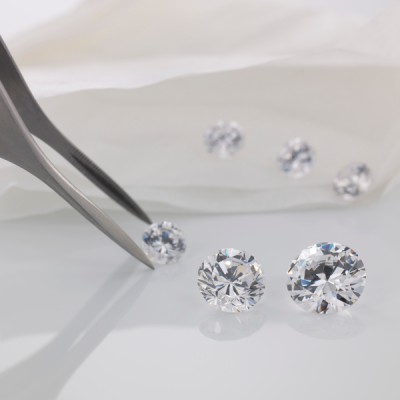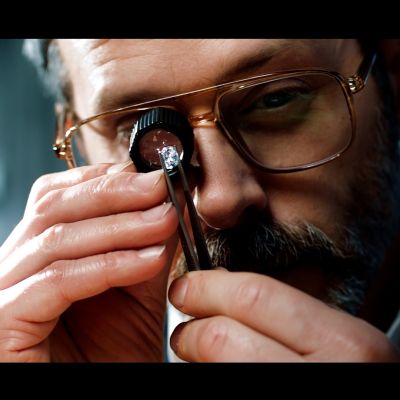Diamond Clarity I1
Diamond clarity is one of the 4Cs you need to know when buying a diamond. Diamond clarity describes a diamond's imperfections or “inclusions” to assess its grade.
What Is Diamond Clarity?
One of the 4 Cs to consider when grading a diamond is diamond clarity which rates the amount and kind of imperfections both on the surface and inside the diamond. Imperfections within the stone are called inclusions, while imperfections on the surface are called blemishes. The fewer inclusions and blemishes a diamond has, the better clarity grade it receives.
|
Highest Clarity Grade Lowest Clarity Grade |
|||||
|
FL |
IF |
VVS1, VVS2 |
VS1, VS2 |
SI1, SI2, |
I1, I2, I3 |
|
Flawless |
Internally Flawless |
Very Very Slightly Included |
Very Slightly Included |
Slightly Included |
Included |
How Are Diamond Clarity Grades Determined?
Diamond clarity grades are determined by using the GIA (Gemological Institute of America) clarity scale. This scale was developed because previously, jewelers didn’t have an established and universal way to talk about diamond clarity. Using the GIA scale is now standard practice when evaluating and purchasing diamonds.
The GIA scale has 11 different grades. Here’s a brief explanation of what each grade means:
Flawless (FL)
While each diamond is unique, Flawless, or FL diamonds come as close to perfect as possible. Flawless diamonds have no inclusions or blemishes detected by a skilled grader under 10X magnification. Flawless diamonds are incredibly rare.
Internally Flawless (IF)
Internally Flawless diamonds have no inclusions and only blemishes visible to a skilled grader under 10X magnification. IF diamonds are still incredibly rare!
VVS1 and VVS2
Very very slightly included diamonds have incredibly marginal inclusions that range from extremely to very difficult for a skilled grader to see under 10X magnification.
VS1 and VS2
Very slightly included diamonds have minor inclusions that range from difficult to somewhat easy for a skilled grader to detect under 10X magnification.
SI1, SI2
Slightly included diamonds have noticeable inclusions that range from easy to very easy to see for a skilled grader to detect under 10X magnification. You’ll usually be able to detect these inclusions by taking a careful look at the diamond.
I1, I2, I3
Included diamonds have obvious inclusions and are clearly visible to a skilled grader under 10X magnification. This clarity grade can affect brilliance and transparency.
What Affects Diamond Clarity?
There are five different factors that affect diamond clarity: size, nature, position, color, and quantity of inclusions and blemishes. While these factors are evaluated in a complex way, generally the larger or more severe the inclusion, the more this inclusion will affect the clarity grade.
Understanding The Different Types Of Diamond Inclusions
There are many types of diamond inclusions. Below is a brief description of each inclusion type:
Bearding: Small hairs gathering around the girdle (widest) area due to improper bruting process. While small amounts of bearding are okay, grey fuzzy bearding is not.
Graining: Whitish or colored reflective lines. Graining is caused by irregular internal crystal growth.
Cavity: A deep opening in the crystal’s surface, often created during the polishing process.
Crystals: Tiny pockets of minerals inside the diamond. Sometimes crystals are tiny embedded diamonds, carbon, or other jewels. Colored crystal inclusions are undesirable, while colorless ones have less impact on clarity grade.
Cloud: Broad classification of crystal or pinpoint clusters. Depending on the cloud, it can affect the diamond’s transparency. Large clouds have a hazy effect.
Feather: A small crack in the diamond that can be invisible or catch the light, depending on where the feather is. Large, severe feathers sometimes have undesirable coloring or can make the diamond less durable. Avoid large feather inclusions, especially near the girdle area.
Needle: A thin, needle-shaped inclusion that looks like a tiny rod inside the diamond, which can be transparent or whitish.
Pinpoints: Tiny white or black embedded crystals in the diamond. Pinpoints are the least offensive type of inclusion.
Twinning Wisps: Made up of a combination of different inclusions and look wavy and ribbon-like. Twinning wisps are a result of growth defects within the diamond’s crystal structure.
Chip: A small opening on the surface of the diamond. This inclusion is usually man-made during polishing or setting.
Indented Natural: A part of the diamond that dips below its polished surface, revealing the rough surface of the diamond.
Is Diamond Clarity Important When Buying A Ring?
While a diamond’s clarity grade has a significant impact on its price, it’s not always the most important of the 4C’s to consider. Remember, most blemishes and inclusions can’t be detected by the naked eye. Clarity is less important when it doesn’t appear to affect the diamond’s brilliance or durability. As long as clarity isn’t a top priority, you can get away with a lower clarity grade to opt for a higher carat, with little to no visible difference!
Clarity is important to consider when the clarity grade is quite low, and inclusions are visible. Beware of visible, unsightly inclusions sometimes seen in slightly included or included diamonds.
Discover Custom, not Customary Fine Jewelry, Designed and Expertly Crafted for you
David Alan is a New York City based fine jewelry atelier with an incredible reputation for capturing and translating your raw emotion and passion into a beautifully balanced, and distinctly unique design. Every part of your David Alan experience contributes to a jewel so personal, it becomes your signature, your talisman, and your future heirloom. Start your journey now.
Engage in a complimentary virtual consultation with David Alan, today!


